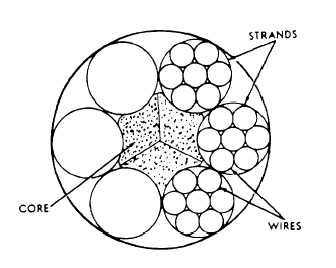10), For best, average, or unfavorable conditions, the following safety factors may often be suitable:
Best conditions (new line): 4;
Average conditions (line used, but in good condition): 6; and
Unfavorable conditions (frequently used line, such as running rigging): 8.
HANDLING AND CARE OF LINES
If you expect the fiber line you work with to give safe and dependable service, make sure it is handled and cared for properly. Study the precautions and procedures given here and carry them out properly.
Cleanliness is part of the care of fiber line. Never drag a line over the deck or ground, or over rough or dirty surfaces. The line can easily pick up sand and grit, which will work into the strands and wear the fibers. If a line does get dirty, use only water to clean it. Do not use soap because it will remove oil from the line, thereby weakening it.
Avoid pulling a line over sharp edges because the strands may break. When you encounter a sharp edge, place chafing gear, such as a board, folded cardboard or canvas, or part of a rubber tire between the line and the sharp edge to prevent damaging the line.
Never cut a line unless you have to. When possible, always use knots that can be untied easily.
Fiber line contracts, or shrinks, when it gets wet. If there is not enough slack in a wet line to permit shrinkage, the line is likely to become overstrained and weakened. If a taut line is exposed to rain or dampness, make sure the line, while still dry, is slackened to allow for the shrinkage.
Line should be inspected carefully at regular intervals to determine whether it is safe. The outside of a line does not show the condition of the line on the inside. Untwisting the strands slightly allows you to check the condition of the line on the inside. Mildewed line gives off a musty odor. Broken strands or yarns usually can be spotted immediately by a trained observer. You will want to look carefully to ensure there is not dirt or sawdust-like material inside the line. Dirt or other foreign matter inside reveals possible damage to the internal structure of the line. A smaller circumference of the line is usually a sure sign that too much strain has been applied to the line.
For a thorough inspection, a line should be examined at several places along its length. Only one weak spot - anywhere in a line-makes the entire line weak. As a final check, pull out a couple of fibers from the line and try to break them. Sound fibers show a strong resistance to breakage.
If an inspection discloses any unsatisfactory conditions in a line, make sure the line is destroyed or cut up in small pieces as soon as possible. This precaution prevents the defective line from being used for hoisting.
WIRE ROPE
LEARNING OBJECTIVE: Upon completing this section, you should be able to determine the use, breaking strength, and care of wire rope used for rigging.
During the course of a project, Seabees often need to hoist or move heavy objects. Wire rope is used for heavy-duty work. The characteristics, construction, and usage of many types of wire rope are discussed in the following paragraphs. We will also discuss the safe working load, use of attachments and fittings, and procedures for the care and handling of wire rope.
CONSTRUCTION
Wire rope consists of three parts: wires, strands, and core (figure 4-5). In the manufacture of rope, a number of wires are laid together to form the strand. Then a number of strands are laid together around a core to form the rope.

Figure 4-5. - Parts of wire rope.
Continue Reading